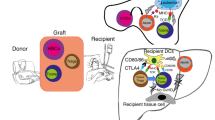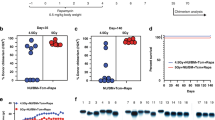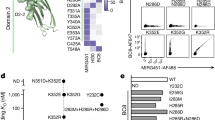Abstract
Antithymocyte globulin (ATG) is often included in the conditioning regimen to prevent graft vs. host disease in allogeneic hematopoietic stem cell (HSC) transplantation. However, because ATG contains antibodies targeting a wide range of antigens on human cells, its potential off-target effects remain a concern. Here, we explored this question in humanized mice that permit the analysis of human cell depletion in tissues. We showed that ATG binds to almost all lineages of human hematopoietic cells including HSCs, and accordingly it is capable of depleting almost all human hematopoietic cells. Interestingly, the efficacy of ATG was highly variable depending on the tissue of residence, with human cells in bone marrow significantly less susceptible than those in the blood and spleen. Recovery of multilineage human lymphohematopoietic reconstitution in humanized mice that received ATG 3 weeks after HSC transplantation indicates that ATG had a minimal effect on human HSCs that have settled in bone marrow niches. However, efficient human HSC depletion and engraftment failure were seen in mice receiving ATG at the time of transplantation. Our data indicate that the efficacy of ATG is tissue-dependent, and suggest a potential risk of impairing donor hematopoietic engraftment when ATG is used in preparative conditioning regimens.
This is a preview of subscription content, access via your institution
Access options
Subscribe to this journal
Receive 12 digital issues and online access to articles
$119.00 per year
only $9.92 per issue
Buy this article
- Purchase on SpringerLink
- Instant access to full article PDF
Prices may be subject to local taxes which are calculated during checkout






Similar content being viewed by others
References
Brennan DC, Schnitzler MA . Long-term results of rabbit antithymocyte globulin and basiliximab induction. N Engl J Med 2008; 359: 1736–1738.
Hardinger KL, Schnitzler MA, Miller B, Lowell JA, Shenoy S, Koch MJ et al. Five-year follow up of thymoglobulin versus ATGAM induction in adult renal transplantation. Transplantation 2004; 78: 136–141.
Cantarovich D, Rostaing L, Kamar N, Ducloux D, Saint-Hillier Y, Mourad G et al. Early corticosteroid avoidance in kidney transplant recipients receiving ATG-F induction: 5-year actual results of a prospective and randomized study. Am J Transplant 2014; 14: 2556–2564.
Lindemans CA, Chiesa R, Amrolia PJ, Rao K, Nikolajeva O, de Wildt A et al. Impact of thymoglobulin prior to pediatric unrelated umbilical cord blood transplantation on immune reconstitution and clinical outcome. Blood 2014; 123: 126–132.
Appelbaum FR, Bacigalupo A, Soiffer R . Anti-T cell antibodies as part of the preparative regimen in hematopoietic cell transplantation-a debate. Biol Blood Marrow Transplant 2012; 18: S111–S115.
Bacigalupo A, Lamparelli T, Bruzzi P, Guidi S, Alessandrino PE, di Bartolomeo P et al. Antithymocyte globulin for graft-versus-host disease prophylaxis in transplants from unrelated donors: 2 randomized studies from Gruppo Italiano Trapianti Midollo Osseo (GITMO). Blood 2001; 98: 2942–2947.
Storek J . Impact of serotherapy on immune reconstitution and survival outcomes after stem cell transplantations in children: thymoglobulin versus alemtuzumab. Biol Blood Marrow Transplant 2015; 21: 385–386.
Mohty M . Mechanisms of action of antithymocyte globulin: T-cell depletion and beyond. Leukemia 2007; 21: 1387–1394.
Storek J, Mohty M, Boelens JJ . Rabbit anti-T cell globulin in allogeneic hematopoietic cell transplantation. Biol Blood Marrow Transplant 2015; 21: 959–970.
Leitner J, Grabmeier-Pfistershammer K, Majdic O, Zlabinger G, Steinberger P . Interaction of antithymocyte globulins with dendritic cell antigens. Am J Transplant 2011; 11: 138–145.
Flynn J, Cox CV, Rizzo S, Foukaneli T, Rice K, Murphy M et al. Direct binding of antithymoctye globulin to haemopoietic progenitor cells in aplastic anaemia. Br J Haematol 2003; 122: 289–297.
Grullich C, Ziegler C, Finke J . Rabbit anti T-lymphocyte globulin induces apoptosis in peripheral blood mononuclear cell compartments and leukemia cells, while hematopoetic stem cells are apoptosis resistant. Biol Blood Marrow Transplant 2009; 15: 173–182.
Wunderlich M, Brooks RA, Panchal R, Rhyasen GW, Danet-Desnoyers G, Mulloy JC . OKT3 prevents xenogeneic GVHD and allows for reliable initiation of xenografts from unfractionated human hematopoietic tissues. Blood 2014; 123: e134–e144.
Lan P, Tonomura N, Shimizu A, Wang S, Yang YG . Reconstitution of a functional human immune system in immunodeficient mice through combined human fetal thymus/liver and CD34+ cell transplantation. Blood 2006; 108: 487–492.
Hu Z, Van Rooijen N, Yang YG . Macrophages prevent human red blood cell reconstitution in immunodeficient mice. Blood 2011; 118: 5938–5946.
Lan P, Wang L, Diouf B, Eguchi H, Su H, Bronson R et al. Induction of human T-cell tolerance to porcine xenoantigens through mixed hematopoietic chimerism. Blood 2004; 103: 3964–3969.
Bosch M, Dhadda M, Hoegh-Petersen M, Liu Y, Hagel LM, Podgorny P et al. Immune reconstitution after anti-thymocyte globulin-conditioned hematopoietic cell transplantation. Cytotherapy 2012; 14: 1258–1275.
Xia CQ, Chernatynskaya AV, Wasserfall CH, Wan S, Looney BM, Eisenbeis S et al. Anti-thymocyte globulin (ATG) differentially depletes naive and memory T cells and permits memory-type regulatory T cells in nonobese diabetic mice. BMC Immunol 2012; 13: 70.
Koyama I, Nadazdin O, Boskovic S, Ochiai T, Smith RN, Sykes M et al. Depletion of CD8 memory T cells for induction of tolerance of a previously transplanted kidney allograft. Am J Transplant 2007; 7: 1055–1061.
Pearl JP, Parris J, Hale DA, Hoffmann SC, Bernstein WB, McCoy KL et al. Immunocompetent T-cells with a memory-like phenotype are the dominant cell type following antibody-mediated T-cell depletion. Am J Transplant 2005; 5: 465–474.
Do JS, Valujskikh A, Vignali DA, Fairchild RL, Min B . Unexpected role for MHC II-peptide complexes in shaping CD8 T-cell expansion and differentiation in vivo. Proc Natl Acad Sci U S A 2012; 109: 12698–12703.
Di Rosa F, Pabst R . The bone marrow: a nest for migratory memory T cells. Trends Immunol 2005; 26: 360–366.
Mazo IB, Honczarenko M, Leung H, Cavanagh LL, Bonasio R, Weninger W et al. Bone marrow is a major reservoir and site of recruitment for central memory CD8+ T cells. Immunity 2005; 22: 259–270.
Tokoyoda K, Zehentmeier S, Hegazy AN, Albrecht I, Grün JR, Löhning M et al. Professional memory CD4+ T lymphocytes preferentially reside and rest in the bone marrow. Immunity 2009; 30: 721–730.
Oldenborg P-A, Zheleznyak A, Fang Y-F, Lagenaur CF, Gresham HD, Lindberg FP . Role of CD47 as a marker of self on red blood cells. Science 2000; 288: 2051–2054.
Abe M, Cheng J, Qi J, Glaser RM, Thall AD, Sykes M et al. Elimination of porcine hemopoietic cells by macrophages in mice. J Immunol 2002; 168: 621–628.
Acknowledgements
The authors thank Ms. Meifang Wang and Mr. Zhifu Gan for their excellent animal care. This work was supported by grants from Chinese MOST (973 Program 2015CB964400 and 2013CB966900; 863 Program 2014AA021601), NSFC (81200397, 81273334), National Science and Technology Major Project of China (2013ZX10002008), Chinese Ministry of Education (IRT1133), and NIH (P01AI045897). Supplementary information of this article can be found on the Cellular & Molecular Immunology’s website (http://www.nature.com/cmi).
Author information
Authors and Affiliations
Additional information
Supplementary information of this article can be found on the Cellular & Molecular Immunology’s website (http://www.nature.com/cmi).
Supplementary information
Rights and permissions
About this article
Cite this article
Jin, F., He, J., Jin, C. et al. Antithymocyte globulin treatment at the time of transplantation impairs donor hematopoietic stem cell engraftment. Cell Mol Immunol 14, 443–450 (2017). https://doi.org/10.1038/cmi.2015.92
Received:
Revised:
Accepted:
Published:
Issue Date:
DOI: https://doi.org/10.1038/cmi.2015.92



